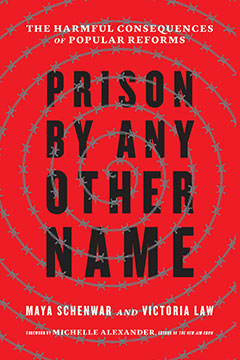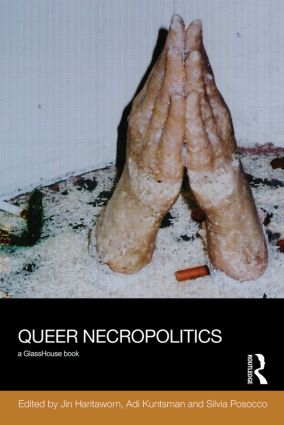I am thrilled to be teaching Prison by Any Other Name this semester in Poverty Law. It’s exactly the right text for this moment, helping students get a wide and deep understanding of how police and prison reforms have failed to resolve problems and ended up expanding the very systems that cause them. I am writing reading questions for my students to help them ensure they are finding the themes in the text and to help them go back to the text throughout the semester. I offer this first set here in case they are useful to other people’s classes or reading groups using this book.

Reading Questions Prison By Any Other Name Intro and Ch 5
Introduction
- Schenwar and Law return to the story of Collette Payne again and again throughout the Introduction, talking about her experience with being imprisoned in her home, her struggle with addiction, her neighborhood, her obstacles to parenting and social life. What did you learn from Collette’s story? What points did it illustrate from the Introduction?
- On p. 3 the authors cite research showing that more incarceration doesn’t reduce crime and may increase it. Why do you think is the case?
- Why are Schenwar and Law concerned that conservatives are working on criminal punishment reform platforms? What’s wrong with people like the Koch brothers collaborating with the NAACP in this way? What questions does it raise?
- Why do the authors say that the First Step Act and other Right on Crime modifications might “entrench the underlying principles of the system” (p. 5-6)? What do you think the underlying principles they are refer to are?
- On p. 8-9 the authors introduce the term “prison nation” from Beth Richie’s work, and the term “prison industrial complex” defined by Rachel Herzing. Why are these terms important to the authors? What do they help us see or understand?
- On p. 10, the authors talk about how dangerousness is framed in criminal justice reforms, particularly when conservatives insist we need to make sure the system keeps imprisoning “people we are afraid of.” They then juxtapose this imagined set of dangerous people to landlords, politicians, and corporations who advocate and create policies that maintain socioeconomic inequality. How might we expand on this critical move of redefining who are the “most dangerous people”? Is there anyone you would add to the list of who is dangerous but isn’t treated like they should be locked up? What might this tell us about where we see and refuse to see violence, or how we define violence to make some kinds of harm invisible?
- On p. 11 the authors raise concerns about reforms that focus on more “sympathetic” people. What are they worried about?
- On the same page, the authors point out that many reforms change the look of confinement, shifting it from criminal punishment facilities to medical or psychiatric facilities. How would a disability justice perspective on criminal punishment reform help us see this problem? Are there things you know about the history of disability justice movement work that could help with this expanded thinking about confinement and injustice? Are there questions you have or things you’d like to know about this?
- What is the problem with trying to make capitivity “kinder and gentler” (p. 12)?
- Schenwar and Law argue, like Davis, that contemporary criminal punishment in the US emerged from slavery and colonialism. Did you notice any new aspects to their argument or did it land any differently with you, reading this idea again?
- If white people are equally likely to use drugs, and more likely to sell them than Black people, why are Black people criminalized for drugs more? How does it work? (p. 14)
- At the top of p. 15, the authors provide a very short summary of how neoliberal economic reforms–reduced taxes, reduced social programs, and increased war expenditure–relate to expanded criminal punishment. What specific polices or laws would you suggest illustrate their points? What else do you know about the items they mention, and other features of neoliberalism, that you would add to that point if you were going to expand it?
- Were you surprised to learn that the immigration detention system we have now that imprisons tens of thousands of people didn’t exist before 2005? Does learning this impact anything about how you see that system?
- How do the authors use the example of the 1984 Sentencing Reform Act to illustrate their arguments on p. 17?
- What are the author’s saying about Mariame Kaba’s idea of “Somewhere Else”?
- Why is prison-like drug treatment unlikely to help people with addictions?
- On p. 22, Schenwar and Law introduce the following question to evaluate reforms: “Are these reforms building up structures we will need to dismantle in the future?” Why is this an important question? What are examples of criminal punishment system reforms that don’t pass this test? Can you think of an example that would pass it?
- On p. 23 the authors talk about freedom and liberation. What do you think these words mean to them? What do you think they mean to the right wing criminal system reformers that they disagree with? What do these words mean to you? What do these words have to do with economic systems, punishment systems, health systems, education systems, energy systems, and transportation systems? What would a “free” world look like, with regard to these systems and the basic needs they meet, to you? Where do you think you got your ideas about what constitutes freedom?
Chapter 5
- What evidence do Schenwar and Law provide that community policing and predictive policing tactics make some communitiies into “open-air prisons”?
- The Black Panther Party and other Black liberation movement organizers in the 1970’s famously asserted that the police were a colonizing force in Black neighborhoods. How does this idea relate to what the authors describe in this chapter? How might the police operate similarly to how a foreign military occupies a city? Various historical and contemporary movements for Black liberation have described the relationship between Black people and the US government as genocidal, or as a war. How might those ideas relate to the information in this chapter?
- On p. 143, the authors note that special police officers are assigned to police public housing in New York City. This is also true elsewhere. What impacts might this have that Poverty Law students would be concerned about? How might people living in housing that has special police assigned to it live differently than people who do not?
- On p. 144, the authors talk about how young people in neighborhoods saturated with police have a hard time hanging out anywhere without being harassed by cops. What do young people do in places that are not targeted with this kind of policing? When you think about these different experiences?
- How does the call for community policing expand policing?
- What impacts do you think it might have on young people to be falsely arrested again and again or to see their friends or siblings experience searches, pat downs, being handcuffed, being thrown on the ground or into police cars, again and again throughout their youth?
- How can you imagined that the kinds of policing described in this Chapter might increase sexual harassment and sexual violence by police?
- What is “broken windows policing” and what are the authors’ concerns about it? (p. 148)
- What are the authors’ concerns about police encouraging community members to come to meetings about safety and identify their safety concerns? What do the authors think is wrong with neighborhood watch programs?
- Is there a way to imagine communities keeping each other safe and having an eye out for each other that is different from the way neighborhood watch programs work now? What would be different?
- On p. 153, the authors describe Project ROSE in Phoenix, where social workers patrolled with police focused on arresting sex workers. From the perspective of a poverty lawyer, what is concerning about this project? Here is an article with more details about Project ROSE for more information.
- Our university, like many, sends campus-wide emails about suspicious people and crimes on or near campus. What impact do you think this has? Does it have any relationship to the kinds of policing we read about in this chapter?
- Law and Schenwar suggest that the way “community” is defined in community policing practices is classed and raced in particular ways that have particular outcomes. How does this defining happen and who is doing it? Who is included and excluded?
- This chapter critiques popular ideas about gangs. How do the authors see gangs differently than how gangs are portrayed in popular media and by public officials? What impacts do they argue gang databases have? Check out these two campaigns that show communities resisting these gang-focused criminalization practices: 1) this campaign to get rid of the gang database in Chicago, 2) this campaign to stop gang injunctions in Oakland.
- Are there any activities primarily taken up by white people that are “gang-like” but authorized by law, which might help as a comparison to how the gang problem is framed in the US? Fraternities? Elite sex and drug conspiracies like those exposed by the Me Too movement and the Jeffrey Epstien case? What about the behaviors of police? Can such comparisons help us critically examine what we are being told is dangerous and where we are being told violence happens?
- Why do the authors say that community policing and predictive policing are public relations strategies for police?
- Community policing frames the problem as “mistrust” between the police and the people they police. What do the authors think is wrong with that framing? A similar framing has been used in recent years about immigrants and police, with various reforms proceeding based on the idea that immigrants need to be able to trust the police. What would the authors say about that?
- What evidence do the authors provide that “racism is baked in” the data gathered by police surveillance methods now being touted as the smart and innovative new way to do policing?
- How would you use the analysis and research in this Chapter to argue against the Trump Administration’s new plans to collect increased personal information from immigrants, including DNA samples?
